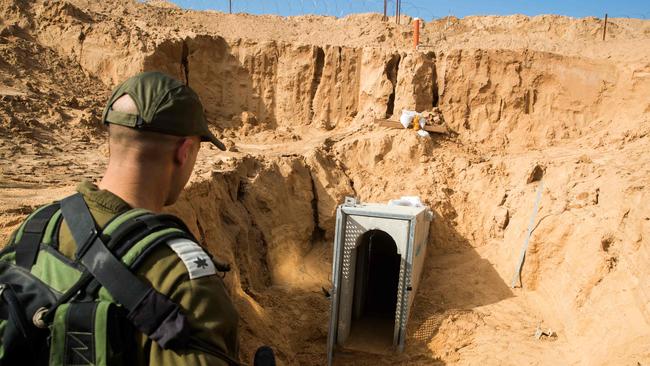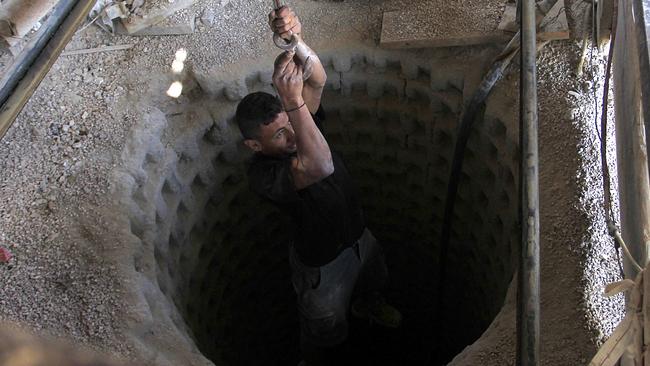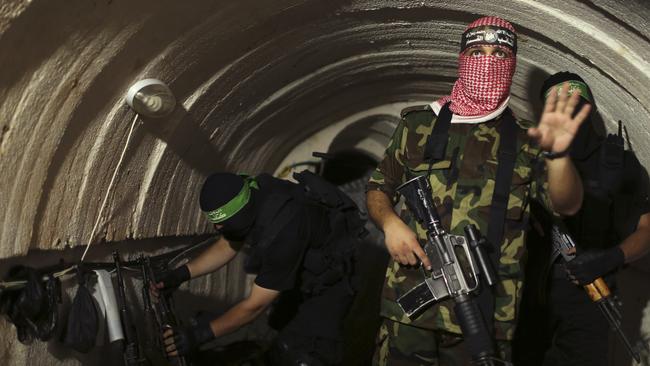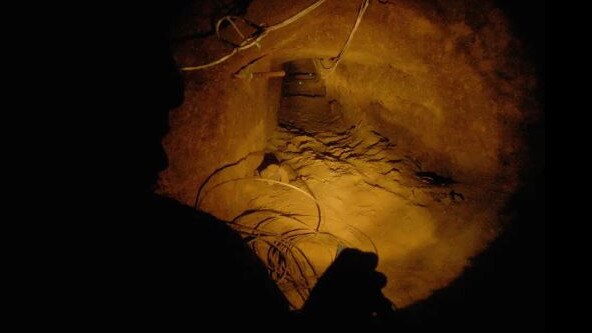Israel’s mission to wipe out Hamas depends on clearing Gaza’s underground network
Using dogs, ‘sponge bombs’ and search-and-destroy teams, Israel’s mission to wipe out the terror group depends on clearing Gaza’s underground network.

Using dogs, ‘sponge bombs’ and search-and-destroy teams, Israel’s mission to wipe out the terror group depends on clearing Gaza’s underground network.
The Israel-Gaza war may be won, or lost, underground. At the al-Shifa hospital in Gaza, Palestinian doctors are relying on a dwindling supply of electricity to keep patients alive: 55 prematurely born babies are depending on generators for their survival, according to one doctor quoted by Reuters last week.
Yet beneath their feet Israel alleges that Hamas has stockpiled, for its own aims, enough fuel to power the generators of Gaza’s largest hospital and keep the incubators running.
Israel has increased the tempo of its war with Hamas, the militia responsible for the October 7 terror attacks, sending columns of tanks into Gaza while also pummelling the enclave’s densely populated cities with a relentless aerial campaign and cutting off communications.
Using bunker-buster bombs, the Israel Defence Forces (IDF) claims it hit 150 underground targets on Friday night. Justifying the bombardment, which resulted in fireballs lighting up the Mediterranean night sky, the IDF released a recording with a Gazan energy official – part of a dossier of evidence claiming that the headquarters of Hamas, including its stockpile of fuel, lies directly beneath the al-Shifa hospital.
Even though the deliberate bombing of medical facilities is a war crime, Rear Admiral Daniel Hagari, the IDF spokesman, appeared to argue that al-Shifa could now be considered a legitimate military target as he presented recordings, satellite imagery and animations of an alleged tunnel network: the nerve centre of Hamas.
The authenticity of the recordings and documents could not be corroborated. But Western intelligence agencies assess that Hamas has indeed stockpiled food and fuel in the tunnels below Gaza to sustain a long insurgency campaign, according to The New York Times.
“You can guarantee the Hamas military has stockpiled for itself all the fuel, water, food and medical supplies it thinks it needs, and will not share them with civilians,” said John Spencer, chairman of urban warfare studies at the Modern War Institute and a former infantryman.
The IDF maintains the main ground offensive has yet to start. However, a succession of night-time raids of increasing frequency and violence suggests that an incremental occupation may be favoured over a blitzkrieg assault.


Israeli Defence Minister Yoav Gallant declared: “Last night (Saturday), the earth in Gaza shook. We attacked above the ground and under it. We attacked terrorist operatives from all levels everywhere.”
The only problem is that Israel has been trying to destroy the tunnels for almost a decade – with limited success.
The IDF claimed it had discovered and demolished 60 miles of tunnels as part of Operation Guardian of the Walls, the 11-day war fought between Israel and Palestinian militant groups in 2021. But the same year, Hamas claimed the “Gaza metro” extended to 300-plus miles in length, making the labyrinth more extensive than the London Tube in an urban area less than half the size.
This week Yocheved Lifshitz, one of four hostages freed by Hamas, described how she was taken there after she was kidnapped from her kibbutz near Gaza. “Eventually we went underground and walked for kilometres ... in a spider’s web of tunnels,” the 85-year-old said.
Smuggling tunnels connecting the Gaza Strip with Egypt date back to the 1980s, and over the years they became so large that thoroughbred horses could be transported in them to supply the territory’s riding club.

Construction began in earnest after Israel withdrew from Gaza in 2005. At a cost of $US3m per tunnel, according to the IDF, Hamas, the militia that came to power in Gaza in 2006, was accused of diverting funds intended for aid programs to build its underground lair.
Gaza’s sandy soil made digging easy, although supporting the tunnels from collapse proved a challenge. Eventually Hamas settled on a standardised system of tunnels 6ft high by 3ft wide and made from prefabricated concrete panels.
The sophistication of the engineering also improved. The deepest tunnel discovered by the IDF so far was 230ft deep – almost as far below ground as the Channel Tunnel is below sea level.
In 2014, the construction boom that had taken place in Gaza was exposed when a dozen militants used a tunnel running under the border with Israel to break into a kibbutz. The Israeli response discovered 32 tunnels in Gaza, 14 of which crossed into Israel. The same year, Hamas was employing 900 people full-time on digging, according to a study by the Rand Corporation, the think tank.

“It’s a city under a city,” said Spencer. “From sending people to places like Iran, Hamas has figured out how to engineer advanced spaces such as command and control rooms. Most of the tunnels have electricity and ventilation. Some even have running water.”
Since grasping the scale of the network, Israel has mostly attempted to destroy tunnels using explosives rather than ordering troops to descend into the unknown. “As the threat evolved, Israel developed aerial, ground and acoustic sensors to find tunnels,” said Spencer.
Given the consistent threat to Israel of Hamas’s system, the IDF has advanced tunnel warfare strategies, such as its Yahalom (“Diamond”) unit of combat engineers – search-and-destroy specialists in breaching tunnels.
Within this branch of the Israeli special forces are sub-units such as Samur (“Weasel”) commandos, trained in subterranean fighting and equipped with ground-penetrating radar and tunnel-mapping robots. A canine sub-unit, Oketz (“Sting”), comprises dog-handlers whose charges are able to sniff out entrances.
“Dogs can go ahead of their soldiers and attack incoming threats – by, for example, biting [fighters’] arms so they cannot shoot,” Spencer said.

One of the complications of subterranean warfare is the inability of the combatants to communicate with the surface. Anything reliant on a satellite will struggle to work so far underground; it also makes GPS navigation tricky.
In addition, Israeli troops descending into the tunnels cannot rely on night-vision goggles, since these usually require some form of ambient light. And firing a weapon in a tunnel can be just as risky for the person shooting it as it is for the target.
Such risks mean the IDF has favoured trying to destroy rather than penetrate tunnels by using bulldozers, bunker-buster bombs or even pouring in cement – a tactic used to stop Hezbollah, the Shia Muslim militia, from building tunnels along Israel’s border with Lebanon.
This approach is similar to the tactics adopted by other armies facing insurgents hiding out in tunnels. In the 1970s, the US relied on B-52s to carpet-bomb the Cu Chi tunnels when it became clear that other attempts to flush out North Vietnamese fighters from their jungle hideouts had failed.
In Ukraine, Russia bombed the Azovstal steelworks in Mariupol incessantly and waited until its last Ukrainian defenders had run out of supplies, forcing their surrender.
The IDF is now deploying similar tactics. In its arsenal are bunker-busters such as the GBU-28, a 5,000lb bomb that can hit targets 100ft under the earth.
Spencer has also seen the IDF use “sponge bombs”, which he said were “a very simple innovation to seal a tunnel rapidly so that you don’t have to go down there”. A plastic box contains two liquids held in separate compartments. After pulling out a metal tube, the liquids can mix and rapidly expand into foam.
“It’s not like they explode – they just expand, similar to industrial foam sprayed underneath homes. Say you pass a small manhole entrance and you want to move past it temporarily, because you never want to leave a tunnel behind you: this is one of the tools you could use.”
On Friday, Israel even signalled exactly where it intends to strike, identifying the location of Hamas’s headquarters underneath a hospital, among whose patients are 55 prematurely born babies.






To join the conversation, please log in. Don't have an account? Register
Join the conversation, you are commenting as Logout